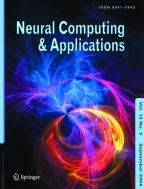864Accesses
2Citations
Abstract
Based on the classical HP memristor found by HP Lab, this paper presents an expanded model that making fully consideration of the influence ofRon, that is,Ron is the similar order of magnitude ofRoff. Simulations proved that in some particular conditions, the hysteresis effect of the expanded model is the same as HP memristor. A comparison was made between these two models under some given conditions. Then, we built several simulations to test the classical characteristics of the expanded HP memristor. Simulation results demonstrate that the expanded model is superior to the original in some aspects like easy switching and power saving. At last, we applied the expanded HP memristor in STDP learning simulation, which shows it is a good candidate for neural network when a threshold voltage function is proposed.
This is a preview of subscription content,log in via an institution to check access.
Access this article
Subscribe and save
- Get 10 units per month
- Download Article/Chapter or eBook
- 1 Unit = 1 Article or 1 Chapter
- Cancel anytime
Buy Now
Price includes VAT (Japan)
Instant access to the full article PDF.











Similar content being viewed by others
Explore related subjects
Discover the latest articles, news and stories from top researchers in related subjects.References
Chua LO (1971) Memristor—the missing circuit element. IEEE Trans Circuit Theory 18:507–519
Strukov DB, Snider GS, Stewart DR, Williams RS (2008) The missing memristor found. Nature 453:80–83
Rozenberg MJ, Inoue IH, Sánchez MJ (2004) Nonvolatile memory with multilevel switching: a basic model. Phys Rev Lett 92:178302
Jo SH, Lu W (2008) CMOS compatible nanoscale nonvolatile resistance switching memory. Nano Lett 8:392–397
Ho Y, Huang GM, Li P (2009) Nonvolatile memristor memory: device characteristics and design implications. In: 2009 IEEE/ACM international conference on computer-aided design digest of technical papers. ACM, New York, pp 485–490
Biolek Z, Biolek D, Biolková V (2009) SPICE model of memristor with nonlinear dopant drift. Radioengineering 18:210–214
Snider G (2007) Self-organized computation with unreliable, memristive nanodevices. Nanotechnology 18:365202
Biolek D, Biolek Z, Biolkova V (2010) SPICE modelling of memcapacitor. Electron Lett 46:520–522
Pershin YV, Ventra MD (2010) Practical approach to programmable analog circuits with memristors. IEEE Trans Circuits Syst 57:1857–1864
Batas D, Fiedler H (2011) A memristor SPICE implementation and a new approach for magnetic flux-controlled memristor modeling. IEEE Trans Nanotechnol 10:250–255
Lin YJ, Hou CL, Su TJ (2009) Cellular neural networks for noise cancellation of gray image based on hybrid linear matrix inequality and particle swarm optimization. In: 2009 international conference on new trends in information and service science. IEEE, New York, pp 613–617
Wen S, Zeng Z, Huang T (2012) Adaptive synchronization of memristor-based Chua’s circuits. Phys Lett A 376:2775–2780
Wen S, Zeng Z, Huang T (2012) Exponential stability analysis of memristor-based recurrent neural networks with time-varying delays. Neurocomputing 97:233–240
Wen S, Zeng Z (2012) Dynamics analysis of a class of memristor-based recurrent networks with time-varying delays in the presence of strong external stimuli. Neural Process Lett 35:47–59
Wen S, Zeng Z, Huang T (2012) Dynamic behaviors of memristor-based delayed recurrent networks. Neural Comput Appl. doi:10.1007/s00521-012-0998-y
Bao G, Zeng Z (2012) Multistability of periodic delayed recurrent neural network with memristors. Neural Comput Appl. doi:10.1007/s00521-012-0954-x
Jiang F, Yang H, Shen Y (2013) On the robustness of global exponential stability for hybrid neural networks with noise and delay perturbations. Neural Comput Appl. doi:10.1007/s00521-013-1374-2
Pershin YV, Ventra MD (2010) Experimental demonstration of associative memory with memristive neural networks. Neural Netw 23:881–886
Wang X, Li C, Huang T, Duan S (2013) Global exponential stability of a class of memristive neural networks with time-varying delays. Neural Comput Appl. doi:10.1007/s00521-013-1383-1
Wang G, Shen Y (2013) Exponential synchronization of coupled memristive neural networks with time delays. Neural Comput Appl. doi:10.1007/s00521-013-1349-3
Chen L, Li C, Wang X, Duan S (2013) Associate learning and correcting in a memristive neural network. Neural Comput Appl 22:1071–1076
Wen S, Zeng Z, Huang T (2012) Associative learning of integrate-and-fire neurons with memristor-based synapses. Neural Process Lett. doi:10.1007/s11063-012-9263-8
Wu A, Zeng Z, Chen J (2013) Analysis and design of winner-take-all behavior based on a novel memristive neural network. Neural Comput Appl. doi:10.1007/s00521-013-1395-x
Snider G (2011) Instar and outstar learning with memristive nanodevices. Nanotechnology 22:015201
Jo SH, Chang T, Ebong I, Bhadviya BB, Mazumder P, Lu W (2010) Nanoscale memristor device as synapse in neuromorphic systems. Nano Lett 10:1297–1301
Chua LO, Kang SM (1976) Memristive devices and systems. Proc IEEE 64:209–223
Snider G (2008) Spike-timing-dependent learning in memristive nanodevices. IEEE Int Symp Nano Archit. doi:10.1109/NANOARCH.2008.4585796
Linares-Barranco B, Serrano-Gotarredona T (2009) Memristance can explain spike-time-dependent-plasticity in neural synapses. Nat Prec.http://hdl.handle.net/10101/npre.2009.3010.1
Gerstner W, Ritz R, Hemmen JL (1993) Why spikes? Hebbian learning and retrieval of time-resolved excitation patterns. Biol Cybern 69:503–515
Cantley KD, Subramaniam A, Stiegler HJ, Chapman RA, Vogel EM (2011) Hebbian learning in spiking neural networks with nanocrystalline silicon TFTs and memristive synapses. IEEE Trans Nanotechnol 10:1066–1073
Ebong I, Deshpande D, Yilmaz Y, Mazumder P (2011) Multi-purpose neuro-architecture with memristors. In: 2011 IEEE international conference on nanotechnology. IEEE, New York, pp 431–435
Author information
Authors and Affiliations
College of Computer Science, Chongqing University, Chongqing, 400044, China
Yu Dai & Chuandong Li
College of Computer Science, Chongqing University of Post and Telecommunications, Chongqing, 400065, China
Yu Dai
College of Mathematics Science, Chongqing Normal University, Chongqing, 401331, China
Hui Wang
- Yu Dai
You can also search for this author inPubMed Google Scholar
- Chuandong Li
You can also search for this author inPubMed Google Scholar
- Hui Wang
You can also search for this author inPubMed Google Scholar
Corresponding author
Correspondence toChuandong Li.
Rights and permissions
About this article
Cite this article
Dai, Y., Li, C. & Wang, H. Expanded HP memristor model and simulation in STDP learning.Neural Comput & Applic24, 51–57 (2014). https://doi.org/10.1007/s00521-013-1467-y
Received:
Accepted:
Published:
Issue Date:
Share this article
Anyone you share the following link with will be able to read this content:
Sorry, a shareable link is not currently available for this article.
Provided by the Springer Nature SharedIt content-sharing initiative


